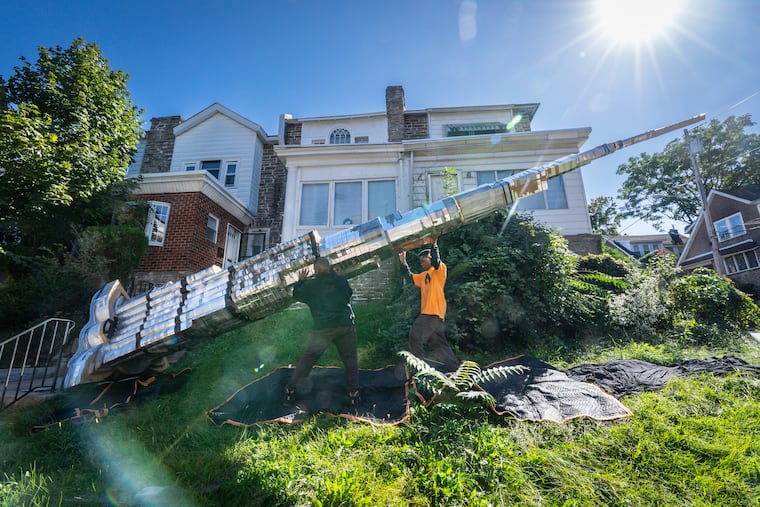Philly artist Kambel Smith, who has autism, built a 26-foot Burj Khalifa out of cardboard
It’s a miniature version of the world’s tallest building.

In my nearly two decades as a journalist, there have only been a handful of times when I’ve left an interview, got into my car, and sobbed.
Most of them happened when I was a crime reporter, after leaving interviews with victims and the relatives of victims whose lives were forever altered by violence in Philadelphia.
But in January 2019, after meeting artist Kambel Smith and his family at their Germantown home, I got into my car and sobbed for an entirely different reason — awe.
“I didn’t know,” I said to myself through tears. “I didn’t know what we’re capable of.”
Kambel, now 36, builds incredibly intricate and impressively massive sculptures of real buildings in Philadelphia and around the world. He does it entirely freehand, without any sketches, drafts, or measuring devices, and he does it with the simplest of materials — cardboard, duct tape, foil, and spray paint.
Earlier this month, Kambel completed his largest sculpture yet — a 26-foot-10-inch replica of the world’s tallest building, the Burj Khalifa in Dubai. His father, Lonnie, who calls his son “The Cardboard King,” plans to submit the piece to Guinness World Records for consideration as the world’s tallest cardboard sculpture (the current record holder is a 25-foot-7-inch Trojan horse).
Entirely self-taught, Kambel, who has autism, works nearly all day, every day on his art (”He stops to eat,” his dad said). Kambel’s talent truly began to flourish when Lonnie, 55, began telling him and his younger brother, Kantai, who also has autism, the story of the Autisarians when they were young.
In the legend created by Lonnie, who’s a single dad, and his sons, Autisarians are people who are given superpowers by what the outside world sees as the “so-called disorder, autism.” By reframing autism as a superpower, Lonnie helped his sons recognize and embrace their talents.
Kantai, 28, is a gifted coder who makes video games and computer-animated movies, and Kambel, well, he hasn’t stopped creating art since I first met him. Back then, he’d already built sculptures of the Divine Lorraine Hotel, Philadelphia City Hall, and the Philadelphia Museum of Art (which remains his favorite piece) and since, he’s built Lincoln Financial Field, the Sydney Opera House, and dozens of other pieces.
Kambel often works in the front yard of his family’s rowhouse, where his work marvels those who walk by.
“Damn, brother, that one is big!” a passerby in a durag said of Kambel’s latest piece. “He’s always doing a great job.”
In 2018, a neighbor who recognized Kambel’s talent helped connect him with Chris Byrne, a curator, gallerist, and owner of the Elaine de Kooning House in East Hampton, N.Y.
Byrne, who has been Kambel’s art curator ever since, has helped him show his work at art shows and galleries in Philly, New York City, Atlanta, and London.
Kambel’s sculptures, which have sold for upward of $25,000, have been acquired by the West Collection, the American Folk Art Museum, and various private collectors.
But his success has not changed the Smith family. They still tell each other stories about the Autisarians and they still live in the same home, where nearly every room is filled to the ceiling with Kambel’s work.
“We’re running out of space and I can’t stop him from building,” Lonnie said. “I told him ‘No more large projects’ right before he built this.”
Kambel has always wanted to build the Burj Khalifa because “it is a cool shape,” he said, but given the size, his father cautioned against it. That is, until earlier this year, when Lonnie said he and Kambel were contacted by a Dubai-based ad agency claiming to work on behalf of a prominent bank in the United Arab Emirates.
He said the agency asked if Kambel would build a sculpture of the Burj Khalifa to be featured at an exhibition and auctioned off. But once the piece was completed, Lonnie said the agency stopped responding to their messages.
“Now we got the Burj Khalifa in the house,” he said.
Kambel built the sculpture in five sections, which nestle atop one another other like stacking blocks and are secured together through a series of holes and large cardboard pegs he built into them. As always, Kambel measured nothing and completed his sculpture in two months. The first time he and Lonnie put it together on its side on their front lawn and pushed it skyward, everything fit together perfectly.
As Kambel took a dry paint brush to his sculpture to dust off some grass, Lonnie and I stood on the sidewalk and talked about Kantai, whose animated movie Impossible Decision has been accepted for distribution on Filmhub and Reveel.
The movie is about a father who is dying and doesn’t have anybody to take care of his autistic son. Having known Lonnie for years, I know this is something he thinks about a lot. He’s not facing any health concerns right now, but he also knows he won’t live forever.
What will happen to his sons when he’s gone is on his mind, all the time. It’s part of the reason he’s so passionate about fostering their talents and their belief in themselves.
“They listen and they let me guide them,” Lonnie said. “I try to put everything together for them for when I’m not around.”
Kambel’s sculpture, which glistens like a real skyscraper, towers far above their two-story home. It is a testament to Kambel’s skill and determination but also to his father’s love, which has nurtured his talent to unimaginable heights.